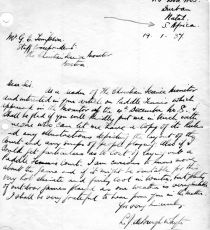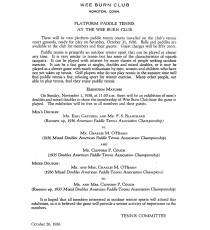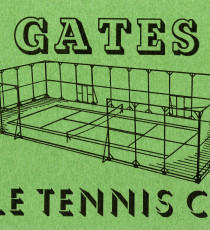Word of the game reaches overseas
Back to Top
In January, 1937, the APTA received a request for information from Durban, Natal, South Africa, after they had read about the sport in the Christian Science Monitor.
Read More

In January, 1937, the APTA received a request for information from Durban, Natal, South Africa, after they had read about the sport in the Christian Science Monitor.
Read MoreFox Meadow Tennis Club teams dominated the Nationals, winning all five events and Charley O'Hearn completed a hat-trick in the Mixed (with Kitty Fuller in 1935 and then with his wife, Virginia, in 1936 and 1937). This was the last year the singles was played until Men's singles was reintroduced in 1980.
Read More

Harold Holmes was affectionately known as “Mr. Paddle of New Jersey” for his tireless efforts on behalf of the game in that state. Holmes, a member of the Tremont Place Paddle Tennis Club in Orange, NJ, was an outstanding player of the early game.
Read MoreLife magazine edition of March 8, 1937, publish an article on Sun Valley, ID which had been founded by W. Averell Harriman and had just opened. The pictures included one of a platform tennis court. Ever the promoter, Blanchard wrote to Harriman to inquire about the state of the game at the resort.
Read MoreConsidered by Blanchard as “one of the greatest steps forward in the history of platform tennis,” Ken Ward created the scrambles format and conducted them at Manursing Island Club. These scrambles tournaments were keys in increasing participation by balancing talents and introducing tournament play without the championship tensions and rivalries. Ken Ward and John Stephenson presided over the draw. The entries were secretly classified into A and B players, and the names of each group put in a separate hat. No two players from the same hat or the same club could play together. Ken Ward and Oz Moore discussed the draw. “I have the worst luck in these scrambles tournaments,” said Ken. “I never seem to draw anybody who is any good. Why, sometimes my partners haven't ever seen a paddle. Of course, if I did get anyone that was any good, they'd all be suspicious.” “I'm [...]
Read MoreThe court was constructed in Central Argyle, half an hour or so SSE of Yarmouth in Nova Scotia, on the property of the Ardnamurchan Club. Ardnamurchan, named after the eponymous peninsular on the west coast of Scotland, is not a club in the traditional sense. During 1908-1909 many acres of land were purchased and a large shingled house built on waterfront property, solely for the purpose of being a summer gathering place for the Cox family, all originally from Philadelphia. The incorporators of the Club included paddle tennis co-founder Fessenden Blanchard's mother-in-law, Martha Cox Bryant, one of eight children. Of course, with the Blanchard family as members, a paddle court was bound to follow and one was built in 1938, ten years after the sport's invention. The first court was very simple and the wires were not very good but still provided fun summer-time recreation. Th[...]
Read More“You know,” said the guilty man enthusiastically, “paddle tennis is the only game I can play with my wife and still like it.”
Read More
The early court construction had been greatly helped by the efforts of Henry B Eaton who was working for a lumber company in NYC. In the late 1930’s, the lumber company was liquidated, but fortunately the work Eaton had done in providing an easy and convenient way for clubs and individuals to obtain platforms inspired one of the company's employees, Joseph Russhon, to take over its platform tennis business and he continued operations as the Gates Sports Platform Company. Thanks to Eaton and Russhon, the early development of the game received a considerable boost, and many platforms were set up. Some of these platforms were erected on top of tennis courts in the fall, and then taken down and stored in the spring. Later, clubs began to find it too expensive and hard on the platforms to put them down and take them up each year and permanent courts came to be the accepted practice[...]
Read More